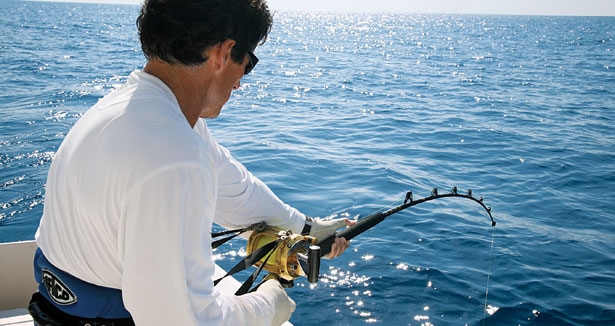Any Caribbean adventure is complimented perfectly with a spot of deep sea fishing. In fact, many people go just for the sport! With sparkling waters, teeming wildlife and a plethora of reefs and wrecks, the area is a world favourite for anglers.
Any deep sea fishing vacation is complimented by a spot of tuna fishing. Yellowfin and Bluefin tuna are some of the most popular game fish around, and so are ideal for beginners and novice fishermen. Even first timers can hope to land beautiful fish of over 300 pounds!
This guide is an introduction to fishing for tuna and is intended as a guide to those who have very limited experience of deep sea fishing before.
First of all, you’ll need to decide whether to fish with a jig or fish with bait on a hook. Ask a local guide what he recommends for the area. The technique once set up is completed is very similar, so be prepared for a fight whichever method you choose!
Jig Fishing
Vertical jigging is an incredibly exhilarating and exciting way to catch tuna; perfect if it’s your first time. You can even jig whilst using other techniques, so a great one of have in the arsenal.
In terms of set up, yellow and Bluefin tuna are going to seriously put you to the test. The right selection of gear is absolutely paramount. Choose around a 7 foot rod and a spinning reel capable of holding around 300 yards of 80 pound test steel braid wire. Add to this a 90 pound fluorocarbon leader. Anything of lesser strength will be munched straight through by an attacking tuna and a long leader is essential for vertical jigging. Leave 15 feet of leader after 5 inches of splicing.
It’s sensible to mark your lines after the first 100m so you know when you are running out of line.
Attach the jig to the split ring, before attaching a solid ring with an assist cord. The assist cord should have attached the jigging hooks. This set up means the fish fight the assist cord rather than the jig. In terms of which manufacturer to choose, there are a number. If it is your first time, ask the captain or a local guide for their recommendations. As a rule of thumb, the jigs should weigh between 3 and 8 ounces depending on the size of tuna you are hoping to catch. Colour isn’t overly important, although most popular are greens, pinks and blues.
Lures should match the tuna’s natural diet as closely as possible, which can change from season to season. Again, ask your local guides for recommendations.
If it’s your first trip, be sure to travel with a group or guides. The crew of the ship will be able to offer you all the help and advice you need before and during the excursion.
Bait Fishing
Bait fishing is mightily exhilarating for beginners through to experienced anglers. The technique is simple; hook up the bait and drop it into the sea. Let the reel out to the specified depth and wait for the fish to bite. You’ll throw in chunks of herring or whiting to attract the tuna too.
When you feel a nibble, it’s time for the battle to commence. Let the reel out for a count of 5 seconds before reeling in and starting your fight. Keep your rod pointing directly towards the fish and manoeuvre around the boat towards it, taking care not to cross lines with your fellow anglers.
Reel in the anchor and start up the engines of the boat; you are in for a battle. Place your rod in holder and ensure you keep the line tight. Reel her in as fast as possible, the fish will begin to circle around under the boat. Wear her out by keeping the line tight, ensuring she can’t make a break for freedom. Once close enough, harpoon the fish and pull her aboard.
Once you have the tuna aboard, remove the harpoon and unhook her mouth. Throw her into the bucket with the rest of your catch and get ready for your next haul. Often the captain will take the tuna back to sell to the market, otherwise they’re all yours!

